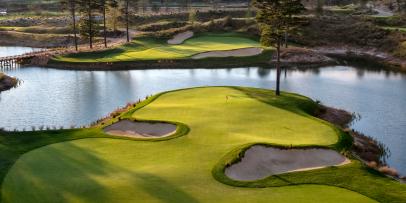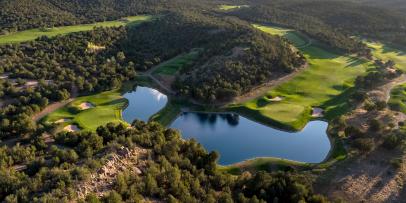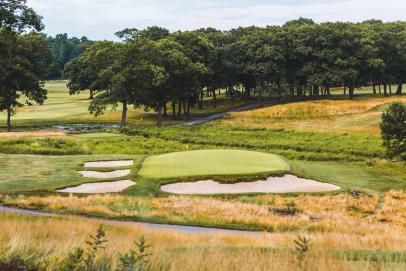Best New
A deeper dive into the year's best new courses and the biggest, most important renovations

Each year, Golf Digest panelists travel the U.S. and Canada to play Best New, Best Renovation and Best Transformation candidate courses, along with every other course listed in our rankings (for more on these categories, see below). For a course to be eligible to win a Best New category it must receive a minimum of 15 evaluations. This can be a challenge when courses open or reopen late in the cycle, as the Best New Public Course winner Landmand Golf Club did in 2022, leaving a small window of time to get panelists there to see them. The requirement nevertheless remains.
Mandating a minimum number of evaluations, however, ensures that the Best New results are based on actual course scores and a baseline level of consensus. In other words, people who have actually played and evaluated the nominees determine the winners, not editors or a panel of writers compiling lists of notable new and renovated courses they haven’t seen. These results are determined by experience, not hearsay or photo-gazing.
Though only a few courses can win the top honors each year, there's a ton of significant work going on around the country—and it's all worth examining. Here's a closer look at all the 2022 nominees.
BEST NEW PUBLIC COURSE
This category is for a course built on new land, or over existing courses where there is an entirely new design, new holes and routings, and new ownership and branding.
WINNER: Landmand, Homer, Neb.

Bill Hornstein

Chris Wheeler/Wheeler Golfscapes
2nd Place: Raindance National, Windsor, Colo. — The newest addition to Front Range golf is a prairie style course from former Arnold Palmer associate Harrison Minchew and playing professional Fred Funk that’s laced with rugged ravines and can be stretched to over 8,400 yards, an asset in the nearly mile-high air. Part of a large resort development that will continue to improve as it matures, there are a number of attractive but heart-pounding all-carry shots over the arroyos, meaning golfers better come with their A-games.

Brian Ross
3rd Place: Park Mammoth G.C., Park City, Ky. — First-time designers Colton Craig and Brian Ross infused a gentle and bucolic but over-the-hill resort course with a vigorous new look, including a completely revamped routing full of wide, rolling fairways, sumptuous green shapes and throwback bunkers. This is a smart and harmonious new design that fits snugly on the land and makes us excited to see what Craig and Ross do next.
RUNNERS-UP

@BrianOar
Bar Run Golf & RV Resort, Roseburg, Ore. — This course in southwest Oregon, just 80 miles from Bandon Dunes, is built atop a family-owned sand and gravel mine. Featuring spacious fairways and three holes along the South Umpqua River, the whimsical character comes from Dan Hixson’s irreverent shaping that takes its cues from the surrounding mountains, the scars of the mining process and even the “Pit” hole at North Berwick with a green guarded by a concrete wall.

Peter Wong
Fox Hills Golf Course, Watford City, N.D. — With acclaimed courses like The Links of North Dakota, Minot Country Club and Bully Pulpit within driving distance, western North Dakota is an unsung golf destination. Reason to travel there got even more convincing with the opening of Fox Hills, a once simple nine-hole layout that Kevin Norby stripped down and rebuilt into an expansive 18-hole course that rides the rolling prairie hills into large greens that can be approached equally well through the air or under the wind along the ground.

Courtesy of the course
Mallard Golf Course, Lake Charles, La. — The new Mallard came about due to a land swap between the City of Lake Charles and the adjacent regional airport that needed the old course’s land for expansion. Designer Jeff Blume used the blank canvas he was given to sculpt broad, open terrain holes that play along lakes and canals and are riddled with undulations and pot bunkers.
BEST NEW PRIVATE COURSE

Brian Oar
Brian Oar
WINNER: The Dye Course at White Oak, Yulee, Fla.

Evan Schiller Photography
2nd Place: Union League National (Grant/Sherman), Cape May Courthouse, N.J. — The backbone of this super-maximalist design from Dana Fry and Jason Straka in the South New Jersey cape are a pair of constructed 40-foot-high central ridges that that half of the complex’s 27 holes scramble up and down. The design is a head-spinning presentation of three different nines that show off electrified putting surfaces stuffed with all manner of tiers, baubles and side slopes, big sandy dunes, scrubby barrens, cavernous bunkers, a section on the north end that mimics holes forged from a quarry and a kaleidoscope of native New Jersey vegetation.
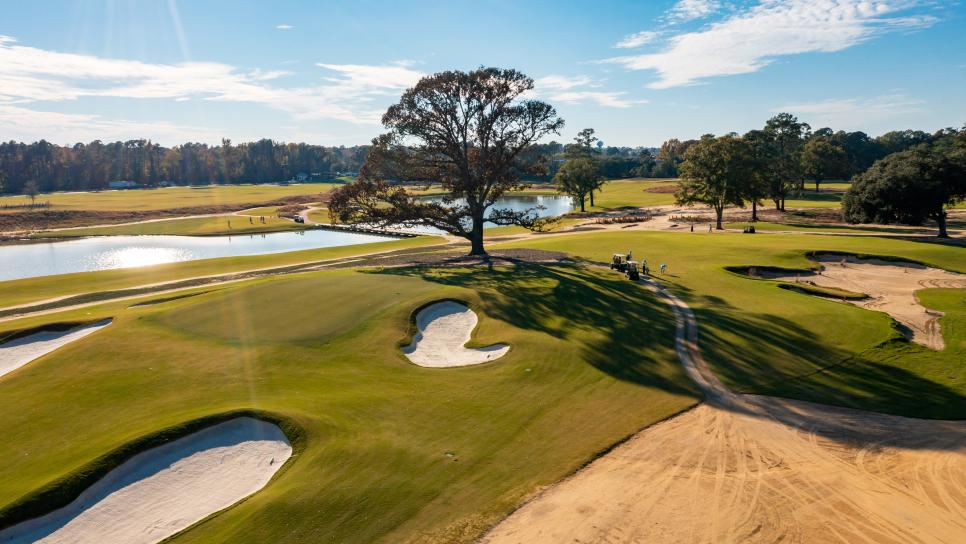
Waxed Design
3rd Place: Quixote Club, Sumter, S.C. — Quixote Club, an hour east of Columbia, is built over the top of an old country club course, although nothing of that design remains. North Carolina-based architect Kris Spence and Jack Nicklaus II created a gorgeous walking course with new holes twisting and turning elegantly through exposed sandscapes and stands of oak and pine. The name of the club is taken from the owners’ altruistically audacious mission of providing funding for a charter school that hopes to turn around the educational opportunities of up to 2,000 local students.

Courtesy of the course
4th Place: Driftwood Golf & Ranch Club, Austin — The latest Tom Fazio/Discovery Land outpost in the Hill Country southwest of Austin plays around clusters of stately live oak highlighted by large bentgrass greens, fairways broad enough to handle the rough Texas winds, and naturally, the company’s signature comfort stations.

WWW.MIKEKLEMME.COM
5th Place: Cutalong at Lake Anna, Mineral, Va.— Located midway between Richmond and Washington D.C., this big, exploratory layout by architect Tom Clark and consultant Ron Whitten (Golf Digest architecture editor emeritus) was two decades in the making. Intended to be the “first true Concept Course of the 21st century,” the wait pays off with a design full of motifs of famous British and American holes, a routing that tackles robust topographical movements, small but highly contoured greens, split fairways and Civil War-inspired fortifications.
RUNNERS-UP

Courtesy of the course
Jack Palmer Photography
Heath Golf & Yacht Club, Heath, Texas — These mostly core-routed 18 holes by Austin-based designer Roy Bechtol are the centerpiece of a master-planned community on Lake Ray Hubbard east of Dallas. Though designed with community play in mind, the course has plenty of teeth with lakes and streams coming into play on 11 holes and a number of forced carries over hazards.

Chip Henderson
Riverton Pointe Golf & Country Club, Hardeeville, S.C. — Formerly known as Hampton Pointe, this property was recently rebranded as an upscale residential community called Riverton Pointe, with a golf course completely overhauled by Nicklaus Design. The layout shows off the lowcountry setting with holes that twist through forests of native pine and oak and bend around lagoons, studded by large, ornately sculptured bunkers and rippling greens with short-grass runoffs.
BEST TRANSFORMATION
This category is for courses that undergo a transformation more profound than a typical renovation. The name and propriety of the course remain the same, but the design work introduces a new architectural concept, and, importantly, new holes, new par values and often re-routed sections of the course.

Brian Oar
WINNER: Entrada at Snow Canyon, St. Georges, Utah

Joey Gladner
2nd Place: Brookside Golf & Country Club, Columbus, Ohio — Brian Silva put an entirely new twist on this 1927 design by rebuilding and expanding greens, shifting classical-era-inspired bunkers to more consequential locations, thinning trees and adding a newly conceived par 3. The transformation pushes this club into the first tier of a competitive Columbus golf market that includes 100 Greatest mainstays like Muirfield Village, The Golf Club, Scioto and Double Eagle.

Tim Sigle Photography
3rd Place: Oakwood Country Club, Kansas City — Todd Clark and consultant Ron Whitten reinvented this 112-year-old course when they added several new holes and sacrificed others. Entire sections of the property have been rerouted, and while some holes maintain their basic shape, this is essentially a brand new course with reconstructed greens, fairways and bunkers all brought up to 21st century standards.

Steve North
4th Place: The Match at Jonathan’s Landing, Jupiter, Fla.—A formerly dead flat 1989 Arthur Hills course was erased and replaced by a new routing and newly conceived holes from Gil Hanse and Jim Wagner. Creative greens, attractive bunkering and a series of drive and pitch par 4s keep the action lively, but the most fascinating aspect of The Match might be how Hanse and Wagner managed to squeeze 18 strategically riveting holes into a tight footprint of barely 90 acres.

Schiller
5th Place: The Match Course at PGA National Resort, Palm Beach Gardens, Fla.—Built over the top of the resort’s former Squire Course, Andy Staples designed The Match exclusively for match play, with no tee markers, gambling half-par holes and assertive putting surfaces that reference famous Raynor/Macdonald templates like the Knoll, Biarritz, Redan and Punchbowl, among others.
RUNNERS UP

Stephen Ruggiero
Hendricks Field Golf Course, Belleville, N.J. – After losing two holes and part of another to make room for a First Tee practice facility in one corner of this municipal course, the County of Essex hired New Jersey-based architect Stephen Kay to rejigger a section of land to the south of Belleview Avenue where he created seven new holes where previously there were only five. In the process he renovated bunkers and greens to better reflect the original 1929 architecture of Charles Banks, adding variations of holes like the Eden, Alps and Double Plateau.

From Port Hope
Port Hope Golf & Country Club, Port Hope, Ont. – Set on bluffs overlooking Lake Ontario, Port Hope boasts one of the region’s most inspired settings. It got even better when the club abandoned several upland holes away from the shore and annexed a 55-acre parcel of farmland near the water on which designer Jason Miller built seven new holes (he revamped the remaining holes as well), including four with greens situated right on the edge of the lake.

Palo Alto Hills Golf & Country Club, Palo Alto, Calif. — Located in the foothills above Palo Alto and south San Francisco Bay, this club has enjoyed a spectacular, serene setting inside a nature preserve since it was built in the late 1950s. Architect Brian Costello has made significant upgrades to each nine over the previous two seasons, including opening hole corridors, reworking the bunkering scheme, and merging some holes while breaking up others to bring the design up to the standards of the views.

Brett Watson
Timpanogos Golf Course, Provo, Utah — The loss of three holes to a medical facility in the northwest corner of this municipal course necessitated the reworking of the rest of the design. Architect Kevin Atkinson pushed, shifted and flipped holes around, and also added four new ones on a previously unused section in the southeast corner. The new course has some fun features—sandy waste areas, wooden bulkheading, an island green, a lighted par-3 course and an 18-hole putting course—so locals get even more bang for their already affordable bucks.
BEST RENOVATION
This category is for courses and clubs that are looking to improve but not necessarily alter what already exists, or seek to return the architecture to some historical version of its past. Work typically includes tree removal, replacing drainage and irrigation, rebuilt tees and greens, new or altered bunkers and fairway expansion.

Dana Fry
WINNER: Hamilton Golf & Country Club, Ancaster, Ontario, Canada
.jpg.rend.hgtvcom.966.644.suffix/1674835518720.jpeg)
2nd Place: Wannamoisett Country Club, Rumford, R.I. — One of Donald Ross’s most unique designs—a par 69 that occupies just 100 acres outside Providence—now better reflects its original heritage following significant property-wide tree removal and Andrew Green’s historically-oriented renovation of the greens and bunkers. Views across the layout are enticing, and the refurbished architecture makes one marvel at how much golf—challenging and frequently mesmerizing golf—Ross, and now Green, managed to stuff into this teacup of a course.

3rd Place: Southern Pines G.C., Southern Pines, N.C. — Kyle Franz is one of golf design’s up and coming stars now that he’s continuing to get major commissions like Southern Pines, a Donald Ross design that dates all the way back to 1906. Franz’s work injecting greens with bold character, removing trees and painting the layout with the kind of scruffy sandscapes indigenous to the Pinehurst region (and to Pine Needles and Mid Pines where he’s previously wielded his art) have elevated this formerly modest public course to the level of its more prestigious neighbors.

Schiller
4th Place: Scioto Country Club, Columbus, Ohio — This is the third Ross-designed course among the Best Renovation finalists, and Andrew Green’s second 2022 renovation in the top four. The work at Scioto was consequential as Green took a tree-lined course stuck in the parkland mode of an early 1960s Dick Wilson remodel and placed it even deeper into the past, 1926 to be exact, the year the club hosted the U.S. Open (won by Bobby Jones). A multi-year tree removal program jump-started the process of restoring the course’s original openness, and Green finished the work by lowering green pads that Wilson had perched up while recreating the dramatic appearance of Ross’s steep bunker faces and articulated putting contours.

Premier Aerials
5th Place: El Caballero Country Club, Tarzana, Calif. — In 2021, Rees Jones went to the San Fernando Valley with longtime associate Steve Weisser to orchestrate a $10 million tee-to-green revitalization of his father Robert Trent Jones’ scenic 1957 original. The upgrade consisted of rebuilding greens and bunkers, installing new drought-tolerant Bermuda fairways and selective tree removal to improve sightlines up and down the San Fernando Valley.
OTHER COURSES
1.jpeg.rend.hgtvcom.966.544.suffix/1674835357460.jpeg)
Long Drive Agency
BraeBurn Country Club, Houston, Texas — This 1926 John Bredemus-designed course has a rich history with ties to Jackie Burke, Sr. (a founder) and Jimmy Demaret (who was once the head professional). Cary Middlecoff, Betsy Rawls and Fred Couples all won tournaments here. In 2021, Tripp Davis renovated the entire course to improve drainage, add irrigation and re-emphasize the strategic thoughtfulness of the design through the shifting of greens and tees, redistributing fairway contour and moving bunkers to more impactful locations.

Courtesy of the course
Broadmoor Country Club, Indianapolis, Ind. — Bruce Hepner’s long relationship with this club has culminated (for now) in a full, multi-year renovation of their 1921 Donald Ross-designed course. One of Ross’s most heavily bunkered courses, Hepner concentrated on rebuilding each hazard (over 130), adjusting fairway and green edges, thinning trees and generally deciphering what was original and what was later added or removed.

Laurence Lambrecht
Brook Hollow Golf Club, Dallas, Texas — Time, and previous renovations, tend to shrink and constrict golf courses. The mission of this remodel by architect Keith Foster was to return Brook Hollow’s worn features to a better iteration of its first-generation A.W. Tillinghast design. Foster achieved magnificent results by accentuating the pedestal-like greens and bringing back their squared-off edges, installing steep-faced bunkers (as opposed to their previously flashed faces) and re-introducing several of Tillinghast's “great hazard” sand wastelands on holes like the par-5 15th.

Courtesy of the course
Coldstream Country Club, Cincinnati, Ohio — Coldstream, opened in 1959, is one of Dick Wilson’s best courses. But like most of the work of his predecessors—Donald Ross, William Flynn, A.W. Tillinghast, et al.—much of the authenticity and nuance had been eroded and erased through time. Keith Foster’s work here, removing trees to restore the grandeur of the holes, expanding fairways and, most importantly, deepening bunkers and adjusting their edging to better reflect Wilson’s intricate shaping, is exceptional.

Patrick Koenig
The Conservatory at Hammock Beach, Palm Coast, Fla. — When a course is designed with as many avant-garde features as Tom Watson built into The Conservatory when it opened in 2006, including grassy dunes, rows of sharp mounds and moguls, lacy sand waste areas, big elevated greens and water everywhere, it’s important to keep the appearance fresh. A $1.2 million bunker renovation, completed in 2021, accomplished this, though the goal was actually to make them shallower, easier to maintain, some more simply shaped and overall less onerous to play out of.

Dornick Hills Country Club, Ardmore, Okla. — Perry Maxwell was known for building some of the game’s best internal putting contours and using the natural topography to inventively guide holes, but most evidence of that genius had disappeared from Dornick Hills, the first course he designed and built between 1914 and 1923. Tom Doak and Eric Iverson of Renaissance Golf used a range of available resources—and their own experience studying Maxwell—to try to recreate his green forms while shifting bunkers and tees, improving drainage and uncluttering trees. It’s a valuable and much-needed reset to this historic property.

John Giustina
Eugene Country Club, Eugene, Ore. — Eugene was the site of one of golf most profound renovations in 1965 when Robert Trent Jones reversed the direction of each hole, and thus the entire course, replacing greens with tees and building tees where greens would have been. The 2021 renovation wasn’t so radical, but the changes initiated by Tim Jackson and David Kahn have made the course more thought-provoking through the shifting of tees, remodeling of bunkers, the expansion of greens that bring more hole locations into play and a renewed emphasis on using the unique ground contours and swales as more strategically influential factors.

Courtesy of the course
Hamilton Farm Golf Club—Highlands Course, Gladstone, N.J. — This project was a kind of re-do for Dana Fry, who designed and built this course in 2001 with then partner Dr. Michael Hurdzan. That version of the course featured elaborate MacKenzie-inspired cape-and-bay bunkers, now replaced by what might be considered a more traditional, or New England, style of shaping with less formality. Their placements have also been adjusted, as have tees, while some fairways were re-graded and hundreds of trees were removed to better show off the 730-acre estate’s surrounding pastures and woods.

James Sylvia
The International—The Oaks, Bolton, Mass. — Architect Tripp Davis says this property outside of Boston, with its forested ambiance and rocky, rollercoaster terrain, demanded a more rugged look. That’s what he and shaper Jason Gold gave it, creating expanses of exposed sand and native grasses and bunker edges that look chewed upon. They also added width to the holes, expanded greens and moved tees to make for more meaningful shot options. The Oaks hosted a LIV Golf Invitational Series in 2022.

PETER J.SCHULZ 2011
Midlothian Country Club, Midlothian, Ill. — Midlothian, in southwest Chicago, was founded in 1898 and is where Walter Hagen won the 1914 U.S. Open. During his recent renovation, architect Ray Hearn recreated shapes and bunker geometries that are more in line with what original architect Herbert Tweedie had—or would have—built, imbuing the course with a turn-of-the 20th century vibe. In rebuilding over 80 bunkers, he turned soft lines hard, extended greens and pushed fairway lines out closer to original dimensions.
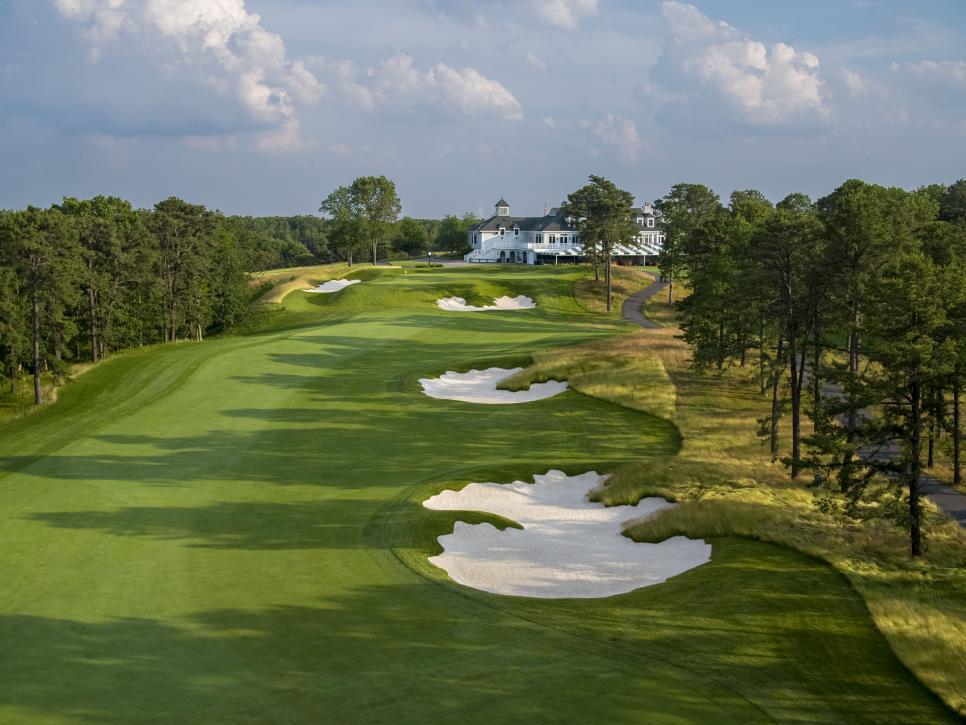
Schiller
Courtesy of the club
Metedeconk National Golf Club—1st/3rd Nines, Jackson, N.J. — The work of Alister MacKenzie, Donald Ross, Perry Maxwell and their kin—even Devereux Emmet and Willie Park, Jr.—has been painstakingly recreated at clubs nationwide for over 20 years. The work of Robert Trent Jones, who worked from the 1930s into the 1990s, is only beginning to get the same treatment. Here at the isolated, spacious Metedeconk National, a late 1980s (and late career) design, Ray Hearn has brought back RTJ’s scratchy, jigsaw bunker lines, expanded the fairways to enhance risk-reward angles and recaptured shrunken greenspace.

Mike Benkusky
Palm Aire Country Club—Champions Course, Sarasota, Fla. — This is the second Dick Wilson design up for Best Renovation in 2022. The Champions course was originally known as “The Green Monster,” a West Coast Florida doppelganger to Doral’s “Blue Monster” on a similarly flat, lake-strewn site. The job for architect Mike Benkusky was not to revive the course’s notorious difficulty but to make it play more functionally and enjoyable for the membership by expanding greens and fairways, building new tee complexes and re-bunkering the layout in a manner more consistent with Wilson’s aesthetic.

Lance Vainik
Lance Vainik
Plum Hollow Country Club, Southfield, Mich. — Architect Drew Rogers wasn’t familiar with Plum Hollow’s history in 2018 when interviewing to develop a masterplan for the club, and was surprised to learn the 1921 course was designed by C. H. Alison, designer of American classics like Milwaukee Country Club, the first nine holes at Sea Island, Knollwood and Burning Tree. After completing several years of work, Rogers has modified the locations and large scale of the bunkers to reflect Alison's prevailing style (his bunkers were often compared to giant clamshells), removed non-native trees and reoriented fairways and grass lines around the greens.

Bill Rocco
Salem Country Club, Peabody, Mass. — Salem was a mainstay on the Golf Digest ranking of America’s 100 Greatest Courses since the list’s inception in 1966, until falling off in 2005. Hoping to jolt the venerable Donald Ross-designed course into relevance, the club hired Eric Iverson to engage in a major, $3.5 million restoration of Ross’s bunkers that also included adjusting and adding tees, redefining fairway lines, increasing hole flexibility on the putting surfaces and taking down several hundred trees that had been choking many of the holes.
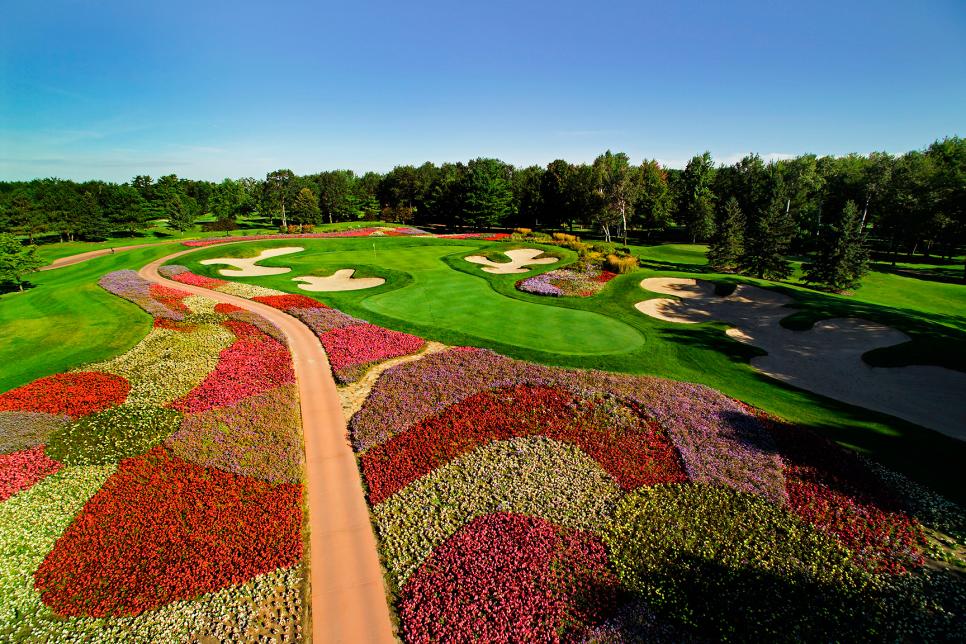
Photo courtesy of SentryWorld
SentryWorld, Stevens Point, Wis. — In an age when almost every renovation consists of enlarging fairway space to provide players better angles for more recoverability for mishits, SentryWorld went the opposite direction, narrowing its landing zones, enhancing roughs and converting a number of chipping areas into maintained bluegrass. The team of Robert Trent Jones II, the original architect, conducted the changes to this popular public course in anticipation of the 2023 U.S. Senior Open Championship, which also included the installation of SubAir systems beneath the greens.
.jpeg.rend.hgtvcom.966.544.suffix/1674837391019.jpeg)
Todd Clark
Tallgrass Country Club, Wichita, Kan. — Simply said, this 1981 Arthur Hills design needed an update. Todd Clark’s renovation consisted of building numerous new tees and placing new bunkers in more thought-provoking locations. Dozens of trees were removed, especially those lining the property’s six lakes, each of which were also cleaned up, and the turf grasses were converted from cool-season varietals to more sturdy, multi-seasonal warm weather strains.
